Detection of Location from Kits Set Up by Vulnerable People during Earthquake Disasters with Communication Blackout: Study Using YOLOv5 Algorithm
Abstract
1. Introduction
1.1. Study Background
1.2. Concept of This Study
- Development of multiple reflectors with different and proposal of a method to determine a victim’s location and needs [3].
- Multiple observations of reflectors using SAR satellites and identification of the range obtained for the reflector values of each shape [3].
- Assembly of proposed reflectors and development of compact storable kit [4].
- Asked elderly persons (who require special consideration during disasters) to put together the assemblable reflector kits and noted their impressions and problems experienced during assembly [4].
1.3. Workflow of This Study
2. Literature Survey and Contributions of This Study
- Studies that describe tools that victims can use to transmit information outside of affected areas and the means to support information within affected areas.
- Studies that utilize SAR satellites during earthquake disasters.
- Studies that detect various objects observed by SAR satellites using deep learning model.
3. Elements of the ASNARO-2 SAR Satellite Used
4. Reflector Setup Experiments and Learning Data
4.1. Data Acquisition through Reflector-Setup Experiments
4.2. Creation and Augmentation of Learning Data
5. Construction of a Reflector Detection Model Using YOLO v5
5.1. Learning Model Preparation
5.2. Preparation of Test Data
5.3. Accuracy Verification of Reflector Detection Model
6. Summary and Pending Issues
6.1. Summary
6.2. Pending Issues
Author Contributions
Funding
Institutional Review Board Statement
Informed Consent Statement
Data Availability Statement
Acknowledgments
Conflicts of Interest
References
- Statistics Bureau, Ministry of Internal Affairs and Communications. 5. An International Comparative View of the Elderly. Available online: https://www.stat.go.jp/data/topics/topi1135.html (accessed on 10 June 2021).
- Cabinet Office Japan, Disaster Management in Japan: Persons Requiring Special Help during Disasters. Available online: http://www.bousai.go.jp/taisaku/hisaisyagyousei/youengosya (accessed on 10 June 2021).
- Morisaki, Y.; Fujiu, M.; Furuta, R.; Takayama, J. Study of efficacy of tool for ascertaining location and needs of persons presumably requiring special consideration immediately after a large-scale earthquake disaster. J. JSCE A1 2021, 77, 649–658. [Google Scholar] [CrossRef]
- Morisaki, Y.; Fujiu, M.; Furuta, R.; Takayama, J. Development of a radar reflector kit for older adults to use to signal their location and needs in a large-scale earthquake disaster. Remote Sens. 2021, 13, 1883. [Google Scholar] [CrossRef]
- Morisaki, Y.; Fujiu, M.; Suwa, T.; Furuta, R.; Takayama, J. Detection location and needs from kits set up immediately after a large-scale earthquake disaster by vulnerable people: Using yolov5 and time series sar images. Intell. Inform. Infrastruct. 2021, 2, 314–323. [Google Scholar]
- Github: Ultralytics yolov5. Available online: https://github.com/ultralytics/yolov5 (accessed on 10 June 2021).
- Osaragi, T.; Oki, T. A real time synchronous system for collecting, sharing, and utilizing disaster information. Trans. AIJ 2017, 82, 2451–2459. [Google Scholar] [CrossRef][Green Version]
- Hiruta, M.; Tsuruoka, Y.; Tada, Y. A proposal of a disaster information sharing system. IEICE Tech. Rep. Inf. Process Soc. Jpn. 2012, 112, 5–8. [Google Scholar]
- Jeong, B.; Zama, S.; Takizawa, O.; Endo, M.; Shibayama, A. Development of a disaster information collection system using cellular phones. J. JAEE 2011, 9, 102–112. [Google Scholar] [CrossRef][Green Version]
- Sugii, K.; Sekizawa, A.; Okabe, H.; Endo, M.; Zama, S.; Araiba, K. Necessity of structuring an effective scheme of acquiring disaster information by fire departments just after an earthquake. J. Soc. Saf. Sci. 2008, 10, 89–96. [Google Scholar]
- Miura, H.; Midorikawa, S.; Matsuoka, M. Accuracy improvement of building damage detection using high-resolution SAR images observed from different directions. J. JAEE 2015, 15, 7_390–7_403. [Google Scholar] [CrossRef][Green Version]
- Hasekura, K.; Gokon, H.; Koshimura, S.; Meguro, K. Verification of a method for determining analysis area of building damage in a tsunami affected area by using L-band SAR data. J. Soc. Saf. Sci. 2016, 29, 47–52. [Google Scholar]
- Sato, H.; Miyahara, B.; Okatani, T.; Koarai, M.; Sekiguchi, T.; Yagi, H. Detection of landslide surface deformation triggered by the 2011 off the Pacific coast of Tohoku earthquake using InSAR image. J. Jpn. Landslide Soc. 2014, 51, 41–49. [Google Scholar] [CrossRef][Green Version]
- Li, C.; Zhang, G.; Shan, X.; Zhao, D.; Li, Y.; Huang, Z.; Jia, R.; Li, J.; Nie, J. Surface rupture kinematics and coseismic slip distribution during the 2019 Mw7.1 Ridgecrest, California earthquake sequence revealed by SAR and optical images. Remote Sens. 2020, 12, 3883. [Google Scholar] [CrossRef]
- Jiang, J.; Fu, X.; Qin, R.; Wang, X.; Ma, Z. High-speed lightweight ship detection algorithm based on YOLO-V4 for three-channel RGB SAR image. Remote Sens. 2021, 13, 1909. [Google Scholar] [CrossRef]
- Tang, G.; Zhuge, Y.; Claramunt, C.; Men, S. N-YOLO: A SAR ship detection using noise-classifying and complete-target extraction. Remote Sens. 2021, 13, 871. [Google Scholar] [CrossRef]
- Hass, F.S.; Jokar Arsanjani, J. Deep learning for detecting and classifying ocean objects: Application of YoloV3 for iceberg–ship discrimination. ISPRS Int. J. Geo-Inf. 2020, 9, 758. [Google Scholar] [CrossRef]
- Remote Sensing Technology Center of Japan, ASNARO-2. Available online: https://www.restec.or.jp/satellite/asnaro-2.html (accessed on 10 August 2022).
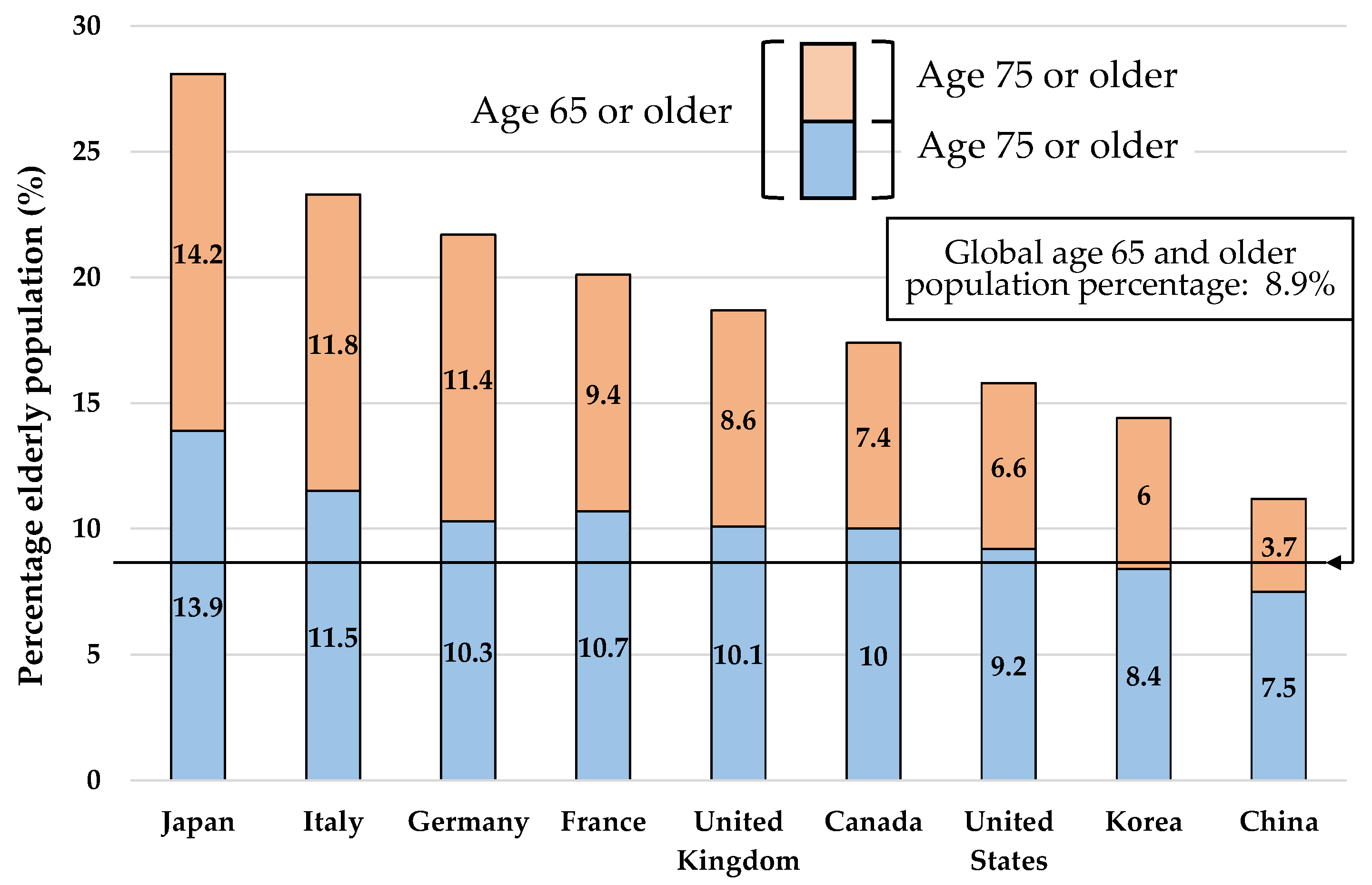
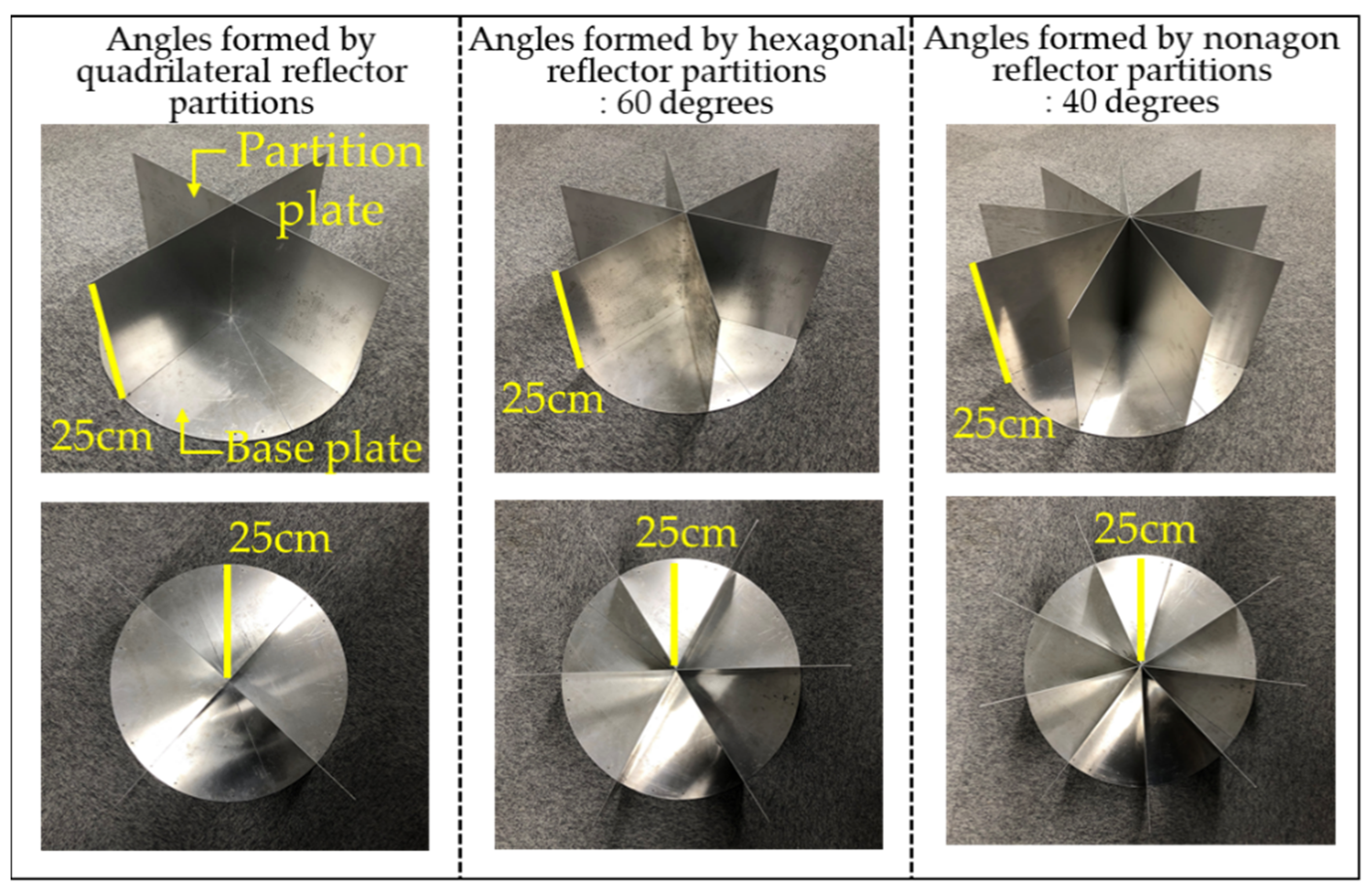

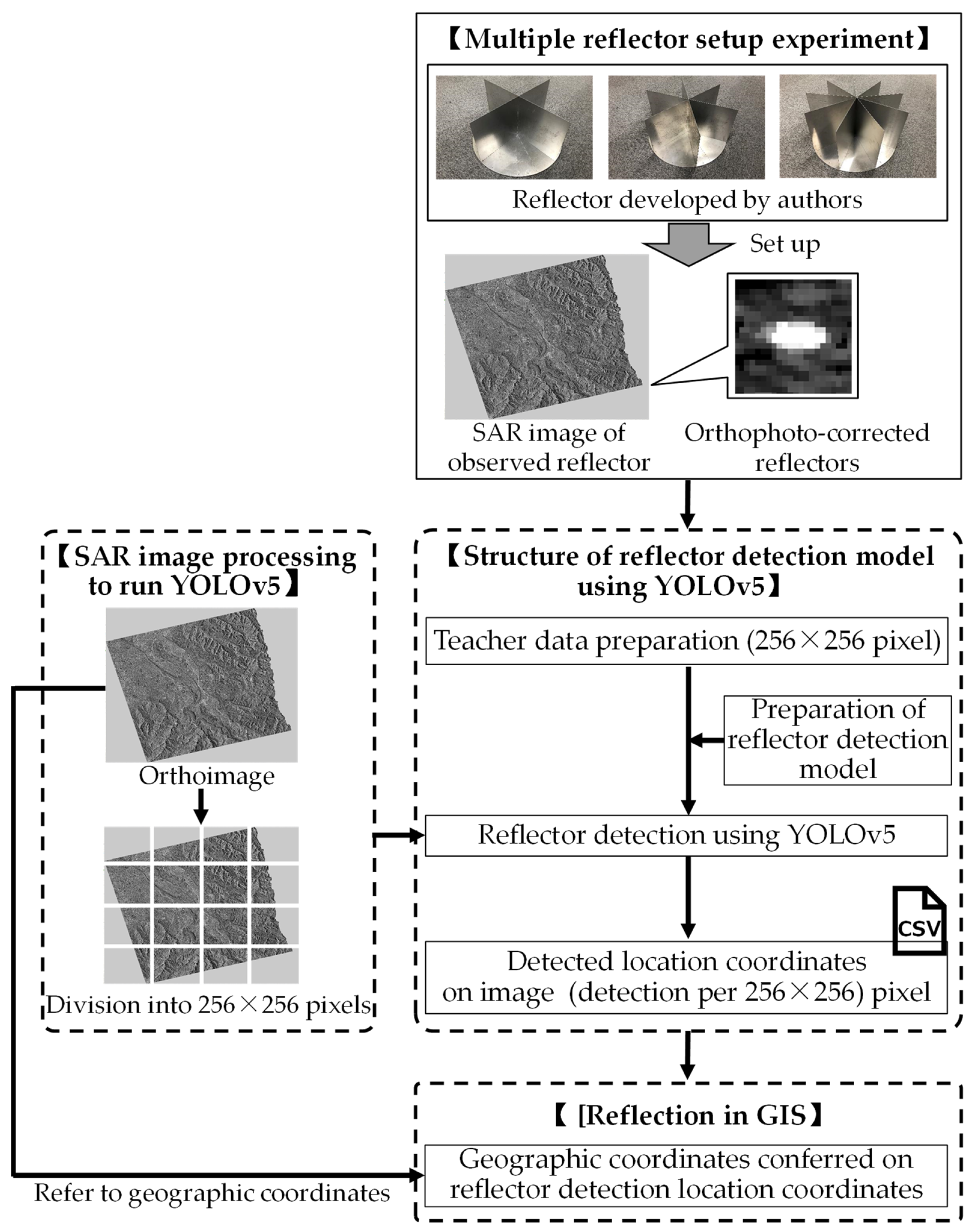
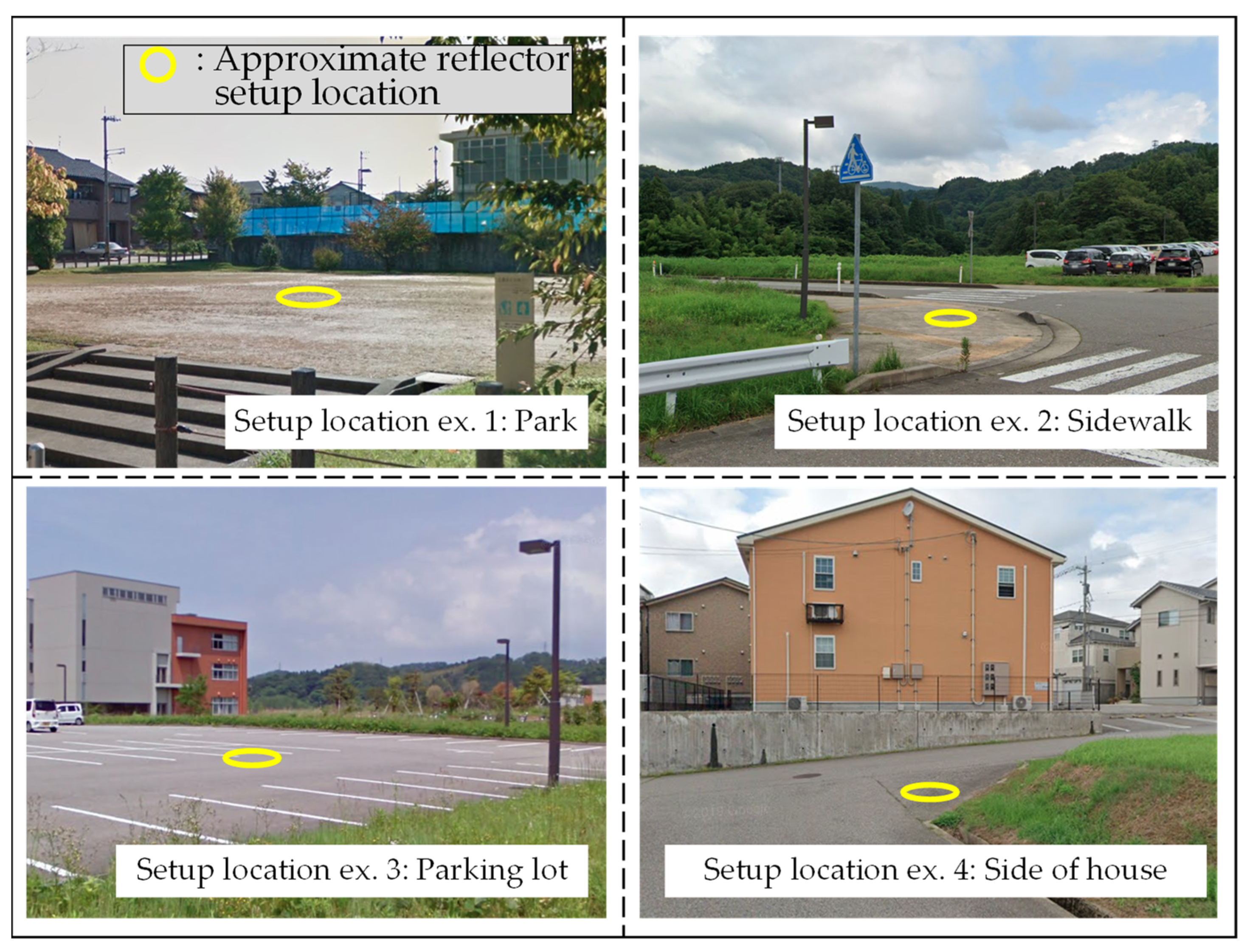
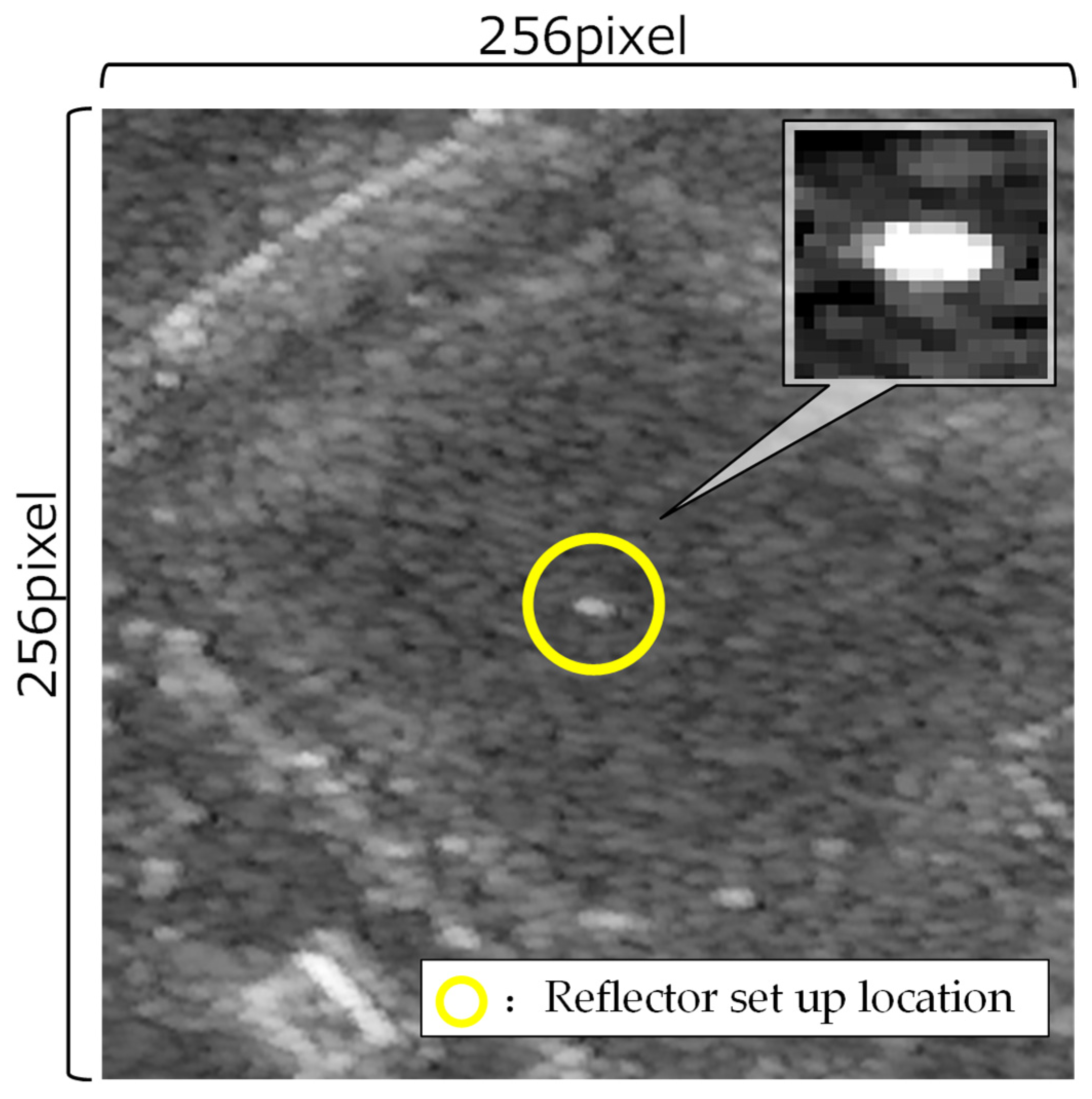
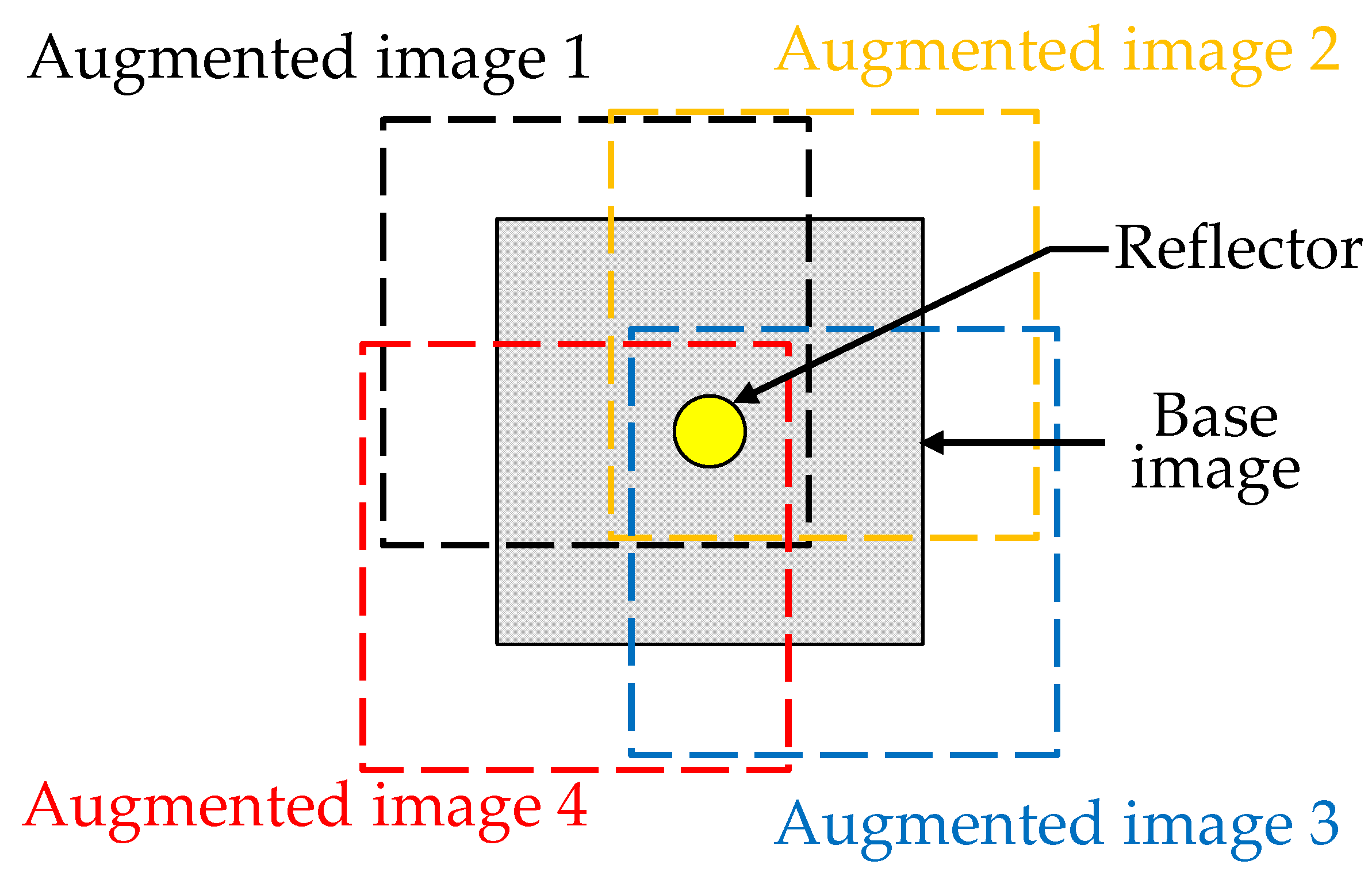
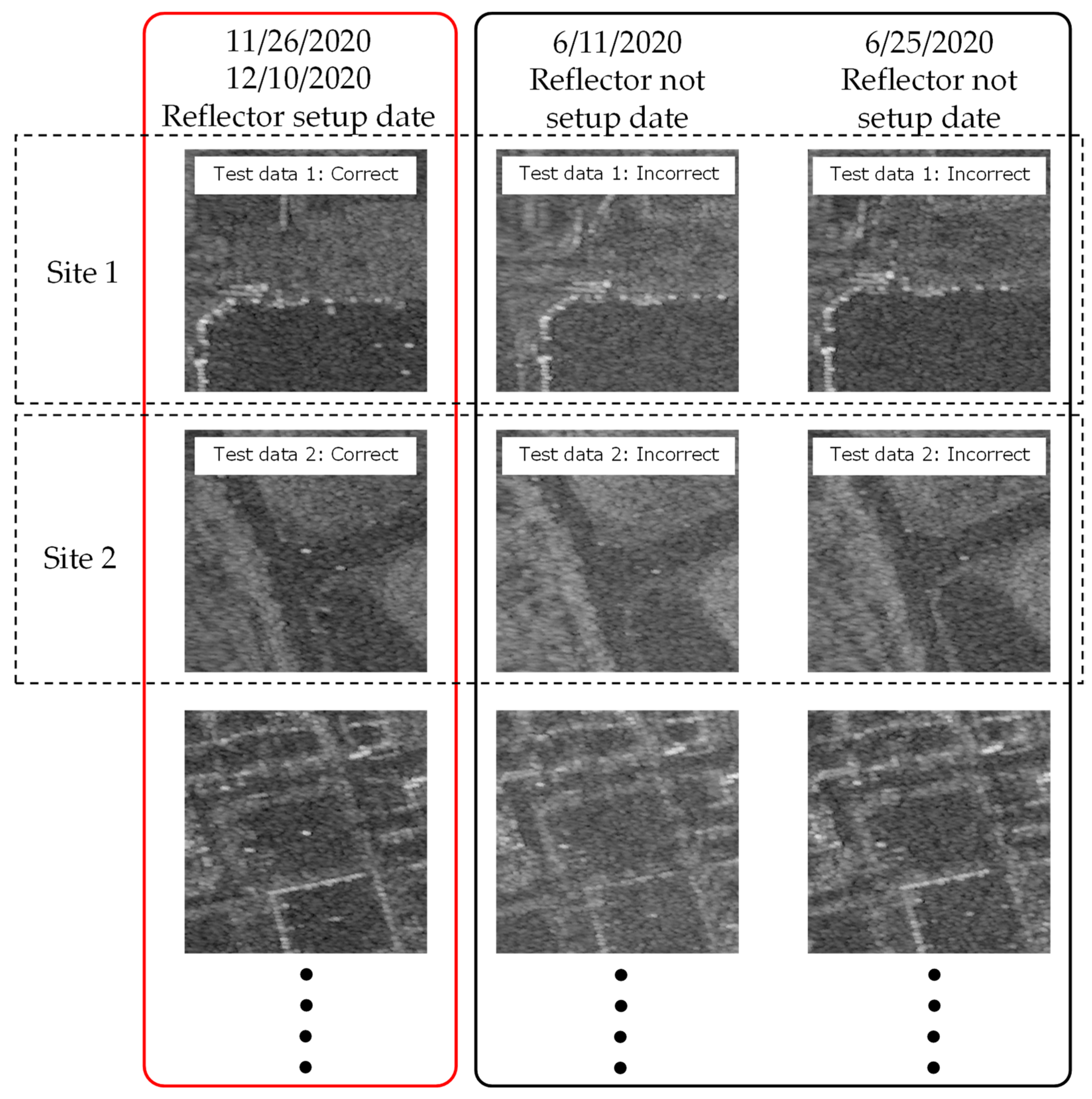
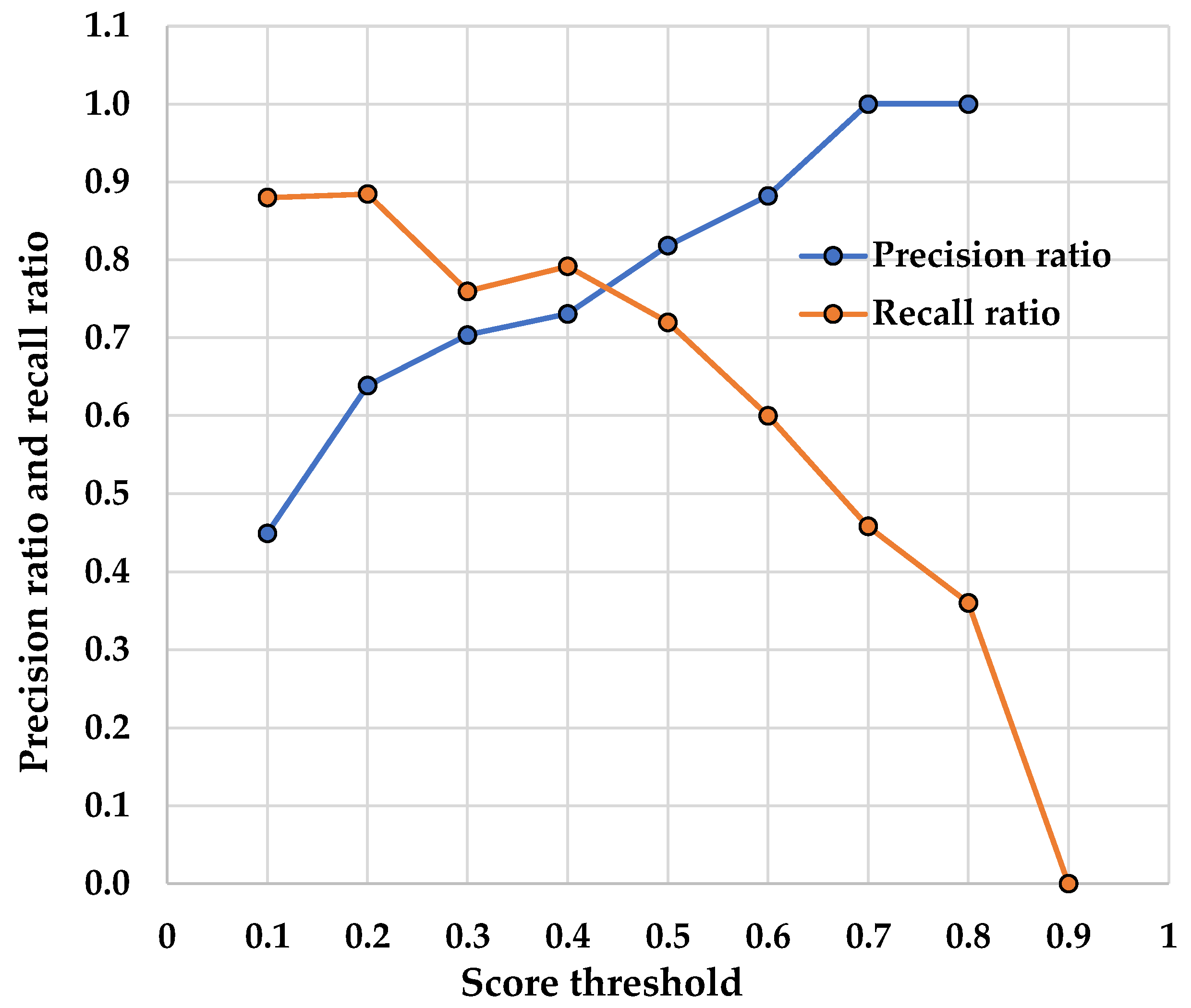
| Operating Agency | NEC (NEDO/METI) |
|---|---|
| Launch date | 17 January 2018 |
| Observation items/purpose | Ascertaining disaster conditions, land management, resource management, etc. |
| Orbit | Synchronous sub-recurrent orbit |
| Altitude | 505 km |
| Regression | 14 days |
| Regression (Japan region during emergency) | 1 day |
| Cycle | 95 min |
| Orbital inclination | 97.4 degrees |
| On-board equipment/type | XSAR (X-band synthetic aperture radar) |
| Observation width/Resolution | Spotlight 10 km/1 m |
| Stripmap 12 km/2 m | |
| ScanSAR 50 km/16 m | |
| Polarization | Dual polarization HH/VV |
| Data Usage | Date/Time of Experiment | Quadrilateral Reflectors (qty.) | Hexagonal Reflectors (qty.) | Nonagonal Reflectors (qty.) | SAR Satellite Moving Direction | Off-Nadir Angle (Degrees) | Radio Wave Irradiation Direction |
|---|---|---|---|---|---|---|---|
| Learning data | 26 May 2020 | 5 | 3 | 4 | Ascending orbit | 43.7 | Leftward |
| 28 May 2020 | 5 | 5 | 5 | Descending orbit | 42.7 | Rightward | |
| 7 July 2020 | 1 | 1 | 0 | Ascending orbit | 43.7 | Leftward | |
| 21 July 2020 | 1 | 0 | 0 | Ascending orbit | 43.7 | Leftward | |
| 22 July 2020 | 4 | 1 | 1 | Descending orbit | 42.7 | Leftward | |
| Test data (reflectors set up) | 26 November 2020 | 6 | 4 | 6 | Descending orbit | 42.7 | Rightward |
| 10 December 2020 | 5 | 2 | 2 | Descending orbit | 42.7 | Rightward | |
| Test data (reflectors not set up) | 11 June 2020 | - | Descending orbit | 42.7 | Rightward | ||
| 25 June 2020 | - | Descending orbit | 42.7 | Rightward | |||
| Score Threshold | Precision Ratio | Recall Ratio | F-Value |
|---|---|---|---|
| 0.1 | 0.45 | 0.88 | 0.59 |
| 0.2 | 0.64 | 0.88 | 0.74 |
| 0.3 | 0.70 | 0.76 | 0.73 |
| 0.4 | 0.73 | 0.79 | 0.76 |
| 0.5 | 0.82 | 0.72 | 0.77 |
| 0.6 | 0.88 | 0.60 | 0.71 |
| 0.7 | 1.00 | 0.46 | 0.63 |
| 0.8 | 1.00 | 0.36 | 0.53 |
| 0.9 | - | 0.00 | - |
Publisher’s Note: MDPI stays neutral with regard to jurisdictional claims in published maps and institutional affiliations. |
© 2022 by the authors. Licensee MDPI, Basel, Switzerland. This article is an open access article distributed under the terms and conditions of the Creative Commons Attribution (CC BY) license (https://creativecommons.org/licenses/by/4.0/).
Share and Cite
Morisaki, Y.; Fujiu, M.; Suwa, T.; Furuta, R.; Takayama, J. Detection of Location from Kits Set Up by Vulnerable People during Earthquake Disasters with Communication Blackout: Study Using YOLOv5 Algorithm. Sustainability 2022, 14, 13895. https://doi.org/10.3390/su142113895
Morisaki Y, Fujiu M, Suwa T, Furuta R, Takayama J. Detection of Location from Kits Set Up by Vulnerable People during Earthquake Disasters with Communication Blackout: Study Using YOLOv5 Algorithm. Sustainability. 2022; 14(21):13895. https://doi.org/10.3390/su142113895
Chicago/Turabian StyleMorisaki, Yuma, Makoto Fujiu, Taiki Suwa, Ryoichi Furuta, and Junichi Takayama. 2022. "Detection of Location from Kits Set Up by Vulnerable People during Earthquake Disasters with Communication Blackout: Study Using YOLOv5 Algorithm" Sustainability 14, no. 21: 13895. https://doi.org/10.3390/su142113895
APA StyleMorisaki, Y., Fujiu, M., Suwa, T., Furuta, R., & Takayama, J. (2022). Detection of Location from Kits Set Up by Vulnerable People during Earthquake Disasters with Communication Blackout: Study Using YOLOv5 Algorithm. Sustainability, 14(21), 13895. https://doi.org/10.3390/su142113895







